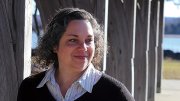On camping trips in northern Ontario as a Boy Scout, David Charbonneau, Ph.D. ’01, Cabot associate professor of astronomy, remembers looking up and watching the stars. “I’d lie on my back with a little star map,” he says, “and try to piece together constellations.” The son of a geologist and a psychiatrist, Charbonneau studied physics, math, and astronomy at the University of Toronto, where he also joined a co-op and applied his scientific acumen to brewing homemade stout. While a graduate student at Harvard, he remained active in co-ops by tutoring at one (through Dudley House) and founding another during a year-long stay in Boulder. In Colorado he also made an important discovery at the High Altitude Observatory. Until 1999, astronomers possessed only indirect evidence of planets in other solar systems, but by measuring the change in a star’s brightness during an eclipse, Charbonneau proved the existence of the planet causing it (see “Distant Planets,” July-August 2000, page 22). That research won him a fellowship to Caltech for postdoctoral study, during which he flew back East on weekends to visit his wife, who was doing her residency at Boston-area hospitals. He joined the Harvard faculty in 2004 and recently received a Packard Fellowship to build eight 16-inch telescopes at the Whipple Observatory on Mount Hopkins in Arizona. His original research turned up only “gas giants”; he will target the new scopes to identify small, rocky planets like our own. “We really are poised,” he says, “to understand whether the solar system is commonplace throughout the galaxy, or whether we’re unique.”
David Charbonneau
David Charbonneau
On camping trips in northern Ontario as a Boy Scout, David Charbonneau, Ph.D. ’01, Cabot associate professor of astronomy, remembers...
You might also like
Landscape Architect Julie Bargmann Transforming Forgotten Urban Sites
Julie Bargmann and her D.I.R.T. Studio give new life to abandoned mines, car plants, and more.
Preserving the History of Jim Crow Era Safe Havens
Architectural historian Catherine Zipf is building a database of Green Book sites.
Julia Rooney’s Cyanotype Art At Harvard
Julia Rooney’s paintings cross the analog-digital divide.
Most popular
Explore More From Current Issue

Harvard In the News
A legal victory against Trump, hazing in the Harvard-Radcliffe Orchestra, and kicking off a Crimson football season with style

A Flu Vaccine That Actually Works
Next-gen vaccines delivered directly to the site of infection are far more effective than existing shots.






